คอมโพเนนต์ OHS ทำให้การปรับใช้ FHIR ง่ายขึ้น คุณจะใช้เครื่องมือเหล่านี้แยกกันหรือรวมเข้าด้วยกันเพื่อสร้างรากฐานของแพลตฟอร์มสุขภาพดิจิทัลแบบครบวงจรก็ได้
แอป Android ที่ใช้ FHIR
การใช้ Android FHIR SDK ช่วยให้นักพัฒนาแอปสร้างแอปพลิเคชัน Android ที่มาพร้อมเครื่อง FHIR ได้อย่างรวดเร็ว SDK คือชุดไลบรารีที่ประกอบด้วยโมดูลต่างๆ ที่ออกแบบมาเพื่อเพิ่มความยืดหยุ่นสำหรับกรณีการใช้งานที่แตกต่างกัน ซึ่งรวมถึงการใช้
- ไลบรารีการบันทึกข้อมูลที่มีโครงสร้างในแอปพลิเคชันที่มีอยู่เพื่อเปิดใช้การรวบรวมข้อมูลผ่าน FHIR
- ไลบรารี FHIR Engine เพื่อสร้างโซลูชันแรกแบบออฟไลน์บน FHIR และ
- ความสามารถขั้นสูงของไลบรารีเวิร์กโฟลว์เพื่อเปิดใช้การสนับสนุนการตัดสินใจทางคลินิกตาม CQL จากเนื้อหาหลักเกณฑ์อัจฉริยะของ WHO
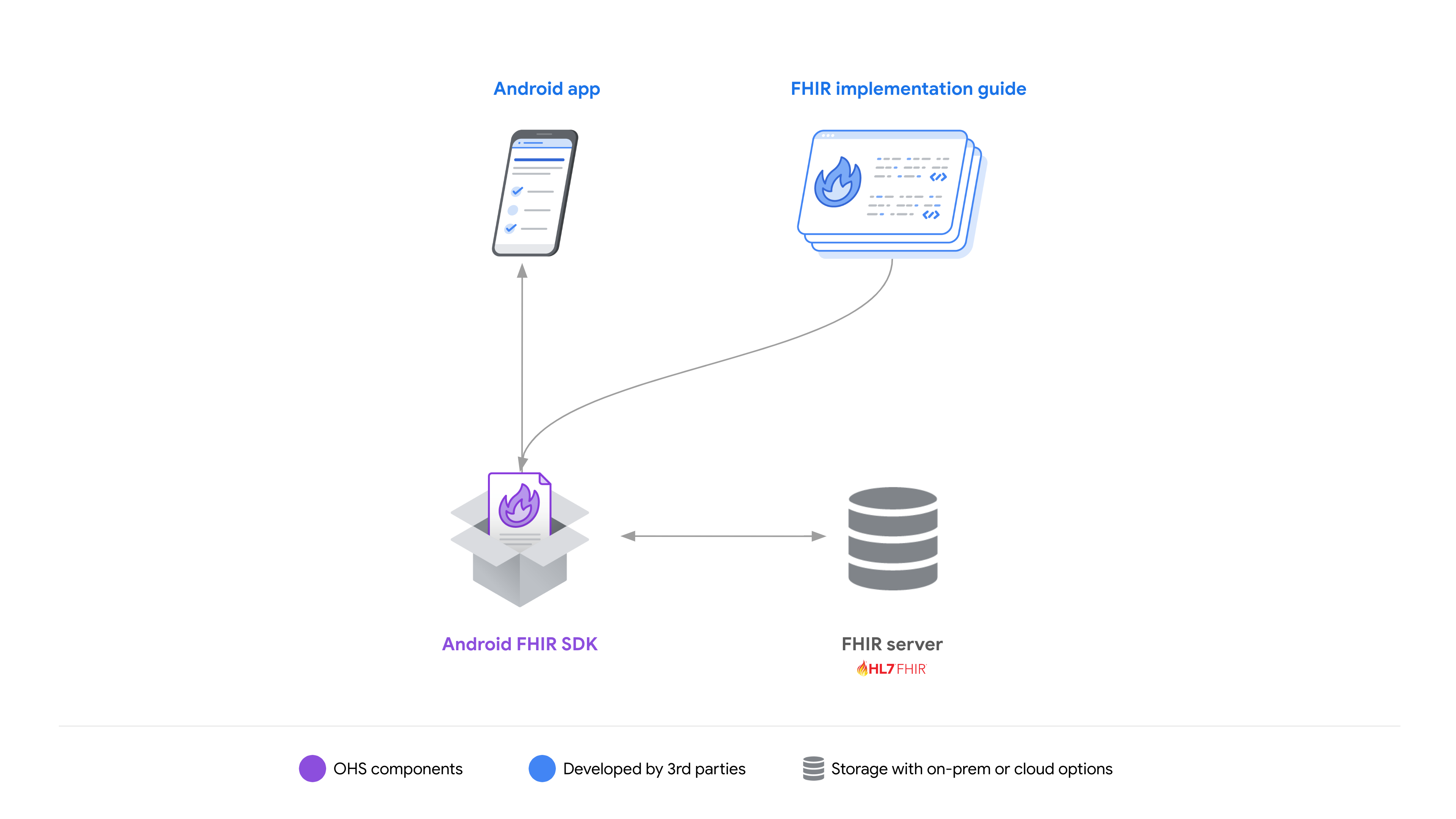
แหล่งข้อมูล
- เริ่มต้นใช้งาน SDC Codelab อย่างรวดเร็ว
- อ่านวิธีที่นักพัฒนาซอฟต์แวร์สร้างโซลูชันอุปกรณ์เคลื่อนที่ ด้วย OHS
การเพิ่มความเป็นส่วนตัว ใช้ประโยชน์จาก SMART-on-FHIR
เกตเวย์ข้อมูล FHIR เป็นพร็อกซีแบบย้อนกลับแบบสแตนด์อโลนที่คุณทำให้ใช้งานได้ด้านหน้าแอปพลิเคชันเพื่อเพิ่มความเป็นส่วนตัว และช่วยให้ใช้นโยบายควบคุมการเข้าถึงขององค์กรได้ง่ายขึ้น เมื่อใช้ร่วมกับแอปพลิเคชันที่ขับเคลื่อนด้วย Android FHIR SDK เกตเวย์ข้อมูลยังช่วยเพิ่มประสิทธิภาพให้กับการดำเนินการซิงค์ได้ เช่น เพื่อจำกัดข้อมูลผู้ป่วยที่ผู้ปฏิบัติงานสาธารณสุขบางคนสามารถดาวน์โหลดและเข้าถึงเมื่อทำงานแบบออฟไลน์ได้
เกตเวย์ข้อมูลรองรับการผสานรวมกับแอปพลิเคชัน SMART-on-FHIR ซึ่งเป็นพร็อกซีแบบสแตนด์อโลน
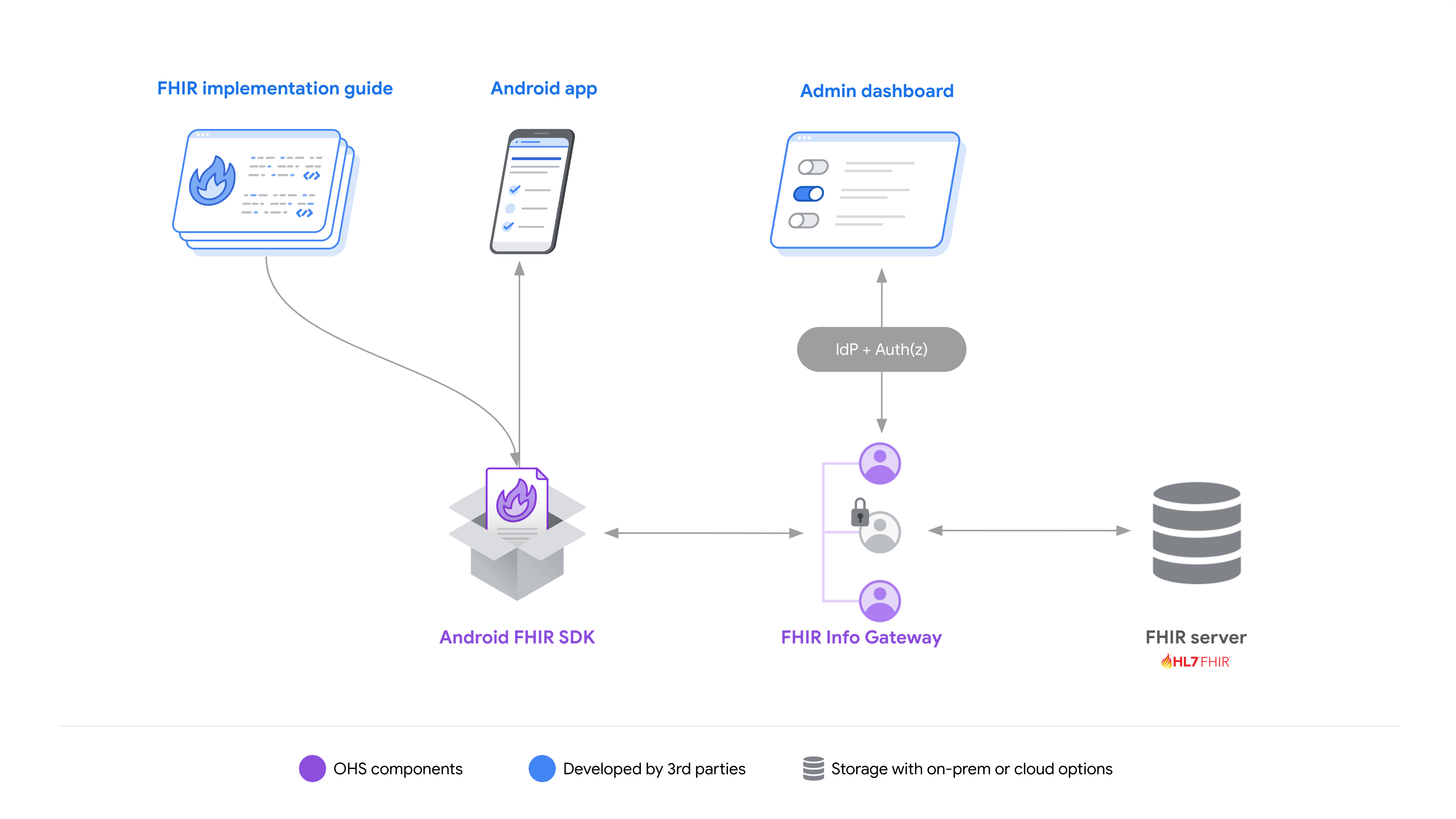
แหล่งข้อมูล
- สำรวจที่เก็บตัวอย่างแอป FHIR เพื่อดูว่าสามารถใช้เกตเวย์ข้อมูล FHIR กับคอมโพเนนต์ OHS อื่นๆ ได้อย่างไร
โซลูชันการวิเคราะห์ FHIR
เนื่องจากข้อมูล FHIR มีโครงสร้างที่ซ้อนหลายระดับ การเขียนการค้นหาเพื่อสร้างข้อมูลเชิงลึกจึงเป็นเรื่องยาก ไปป์ไลน์ข้อมูล FHIR ช่วยลดความซับซ้อนของปัญหาด้วยไปป์ไลน์ที่ทำให้ใช้งานได้ง่ายและปรับขนาดในแนวนอน ซึ่งแปลงข้อมูล FHIR เป็นรูปแบบ SQL บน FHIR ทำให้ค้นหาข้อมูล FHIR ผ่าน SQL ได้
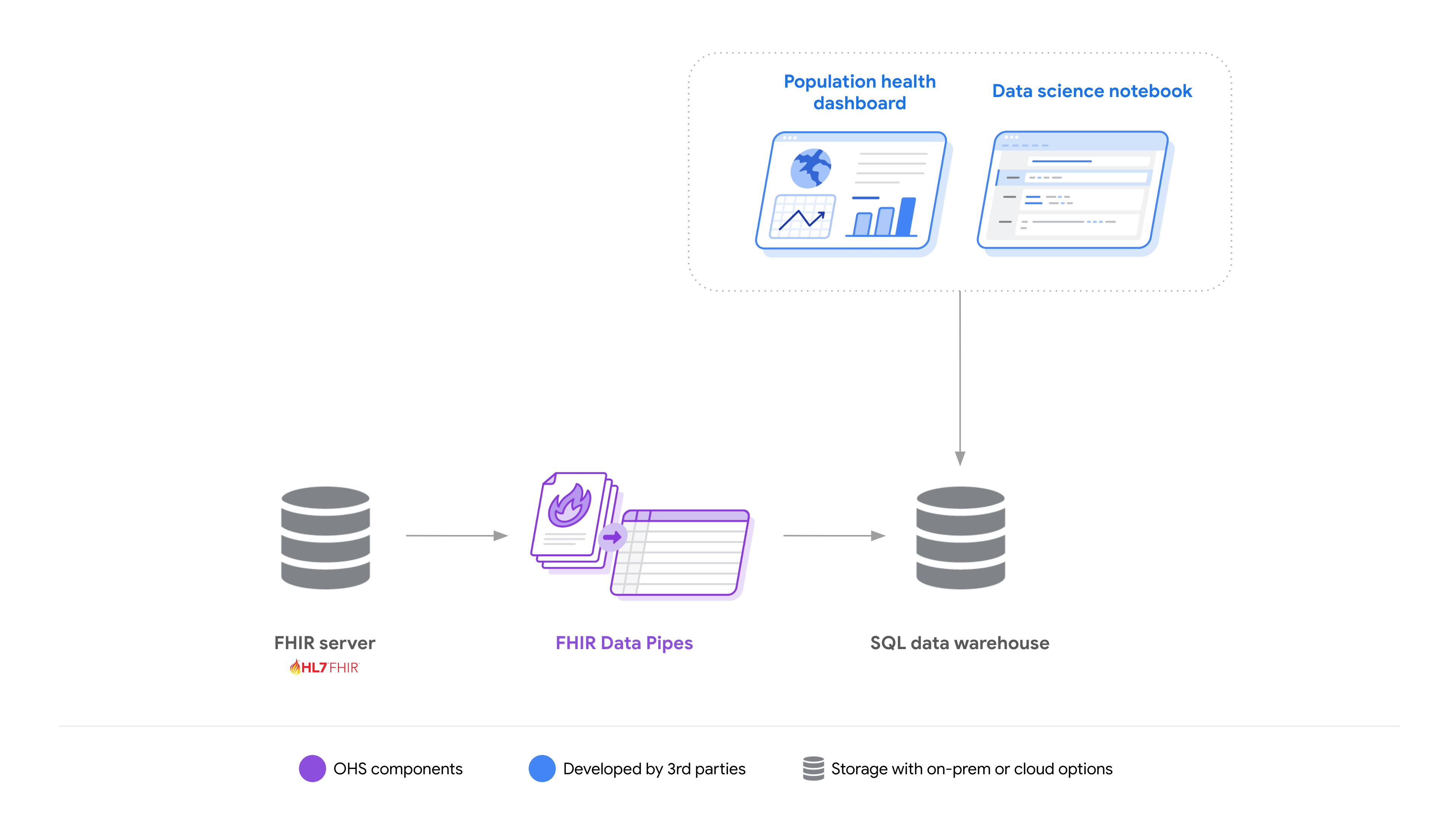
ไปป์ไลน์ข้อมูล FHIR มีประโยชน์เมื่อ FHIR เป็นแหล่งที่มาของข้อมูลที่จะทำการวิเคราะห์ สถานการณ์ทั่วไปสำหรับนักพัฒนาซอฟต์แวร์มีดังนี้
- ดูรากฐานสำหรับโซลูชันสุขภาพดิจิทัลแบบครบวงจรในฐานะส่วนขยายของโซลูชันสุขภาพอุปกรณ์เคลื่อนที่แบบดั้งเดิมของ FHIR
- ดูตัวอย่างสถาปัตยกรรมแบบผสมซึ่งเป็นส่วนหนึ่งของโซลูชันข้อมูลวิเคราะห์แบบสแตนด์อโลนที่ใช้ประโยชน์จาก FHIR
แหล่งข้อมูล
- เริ่มต้นใช้งานอย่างรวดเร็วด้วยบทแนะนำการทำให้เครื่องเดียวใช้งานได้
- สํารวจที่เก็บตัวอย่างแอป FHIR เพื่อดูวิธีการใช้ไปป์ไลน์ข้อมูล FHIR กับคอมโพเนนต์ OHS อื่นๆ
รากฐานสำหรับโซลูชันด้านสุขภาพทางดิจิทัลแบบครบวงจร
การใช้คอมโพเนนต์ OHS ทั้งหมดร่วมกันจะช่วยสร้างรากฐานให้นักพัฒนาแอปสร้างแพลตฟอร์มหรือโซลูชันที่ใช้ FHIR ด้วยการให้บริการฟีเจอร์หลักหลายอย่าง เช่น ความสามารถในการซิงค์และการทำงานแบบออฟไลน์ พร้อมลดความซับซ้อนทางเทคนิคในการทำงานกับ FHIR นักพัฒนาซอฟต์แวร์จึงประหยัดเวลาและมีเวลามากขึ้นในการเพิ่มมูลค่าของโซลูชัน
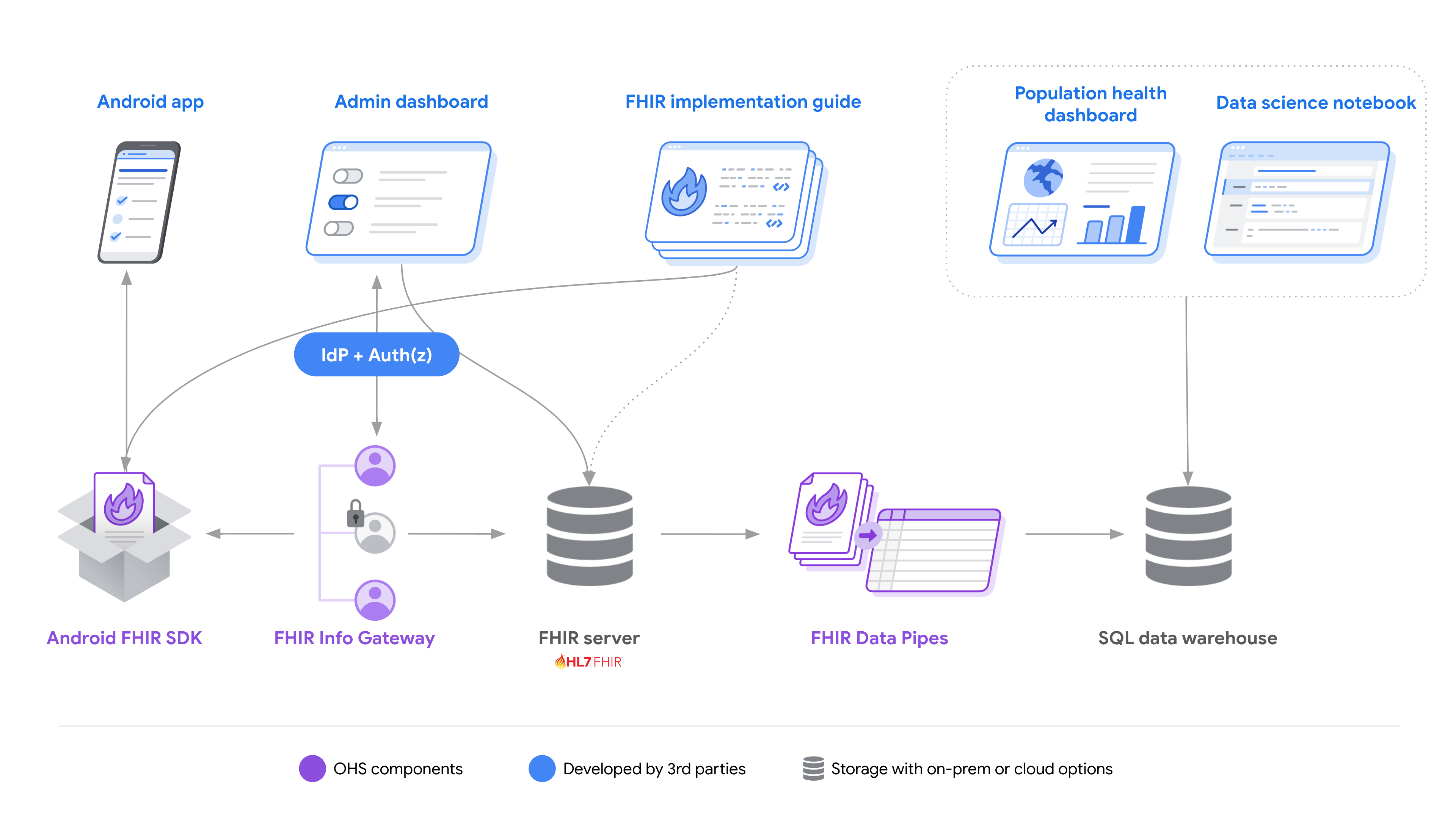
แหล่งข้อมูล
- สำรวจที่เก็บตัวอย่างแอป FHIR เพื่อดูวิธีใช้คอมโพเนนต์ทั้งหมดร่วมกัน
- อ่านวิธีที่ Ona ใช้ OHS ในการสร้าง OpenSRP FHIRCore
ตัวอย่างสถาปัตยกรรมแบบผสม
โมดูลของคอมโพเนนต์ OHS ช่วยให้นักพัฒนาซอฟต์แวร์เลือกส่วนที่จะช่วยแก้ปัญหาที่เจาะจงที่สุดได้
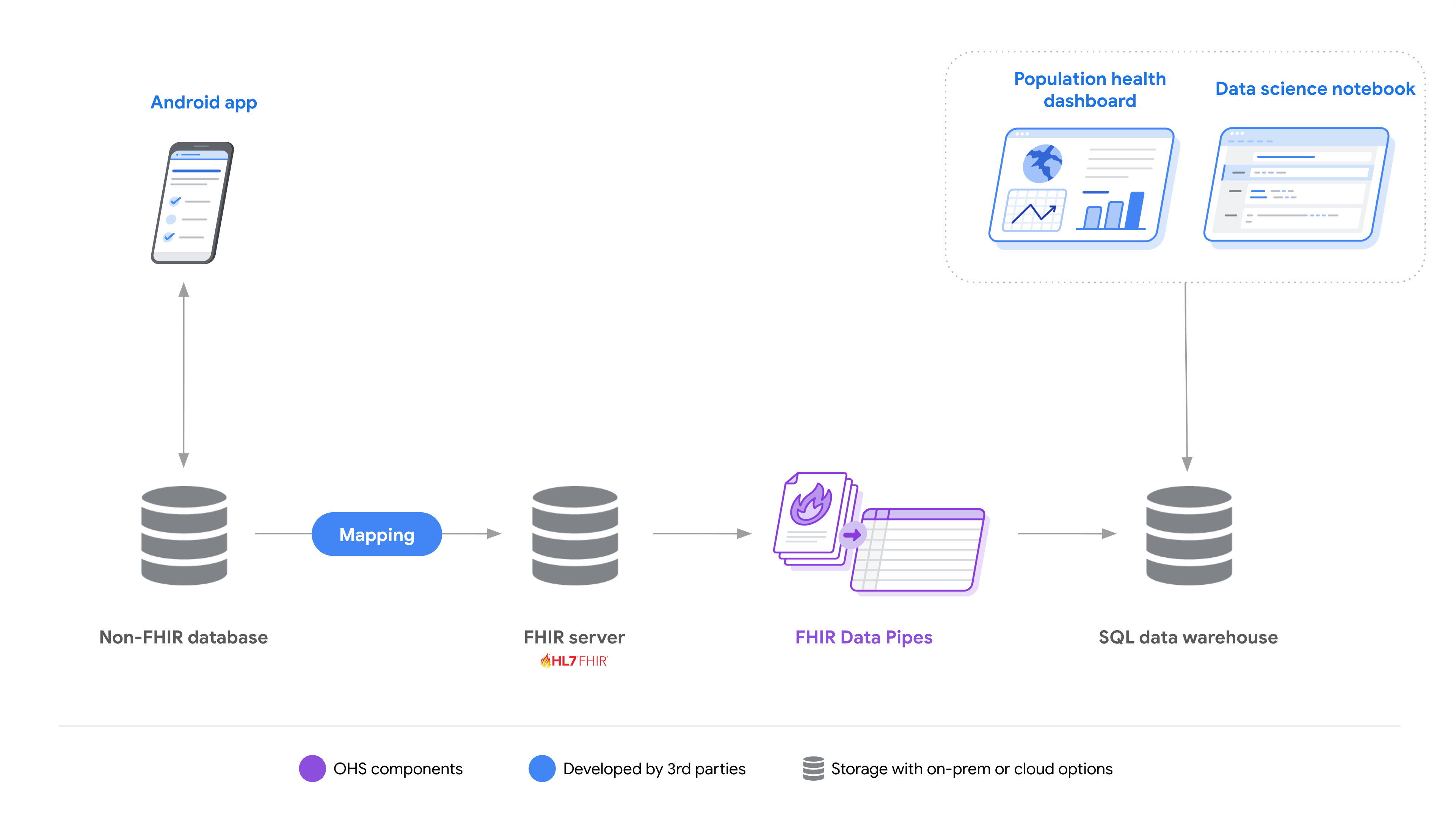
มีตัวอย่างมากมายเกี่ยวกับการเปลี่ยนระบบที่มีอยู่บางส่วนไปใช้ FHIR ในขณะที่ยังคงรักษาส่วนอื่นๆ ของโซลูชันไว้ตามเดิม ซึ่งรวมถึงการใช้งานดังต่อไปนี้
การรวบรวมข้อมูลที่ไม่ใช่ FHIR ไปยังข้อมูลวิเคราะห์ที่อิงตาม FHIR: ในสถานการณ์นี้ ข้อมูลที่เก็บรวบรวมในแบบที่ไม่ใช่ FHIR จะแปลงเป็น FHIR เพื่อเปิดโอกาสให้มีการใช้ไปป์ไลน์ข้อมูล OHS FHIR สำหรับแนวทางทั่วไปในการสร้างข้อมูลเชิงลึกจากข้อมูล FHIR ในการเปลี่ยนรูปแบบข้อมูล นักพัฒนาแอปสามารถใช้ API ผู้ให้บริการที่มีอยู่, บริการของบุคคลที่สามที่มีอยู่ เช่น OpenFn ที่อนุมัติของสินค้าทั่วโลก หรือใช้ประโยชน์จากโปรเจ็กต์โอเพนซอร์สที่เกี่ยวข้อง
แอป FHIR ที่มาพร้อมเครื่องกับระบบที่ไม่ใช่ FHIR: ในสถานการณ์นี้ แอปบนอุปกรณ์เคลื่อนที่แบบ FHIR ที่สร้างขึ้นโดยใช้ Android FHIR SDK จะใช้สำหรับการนำส่งบริการทางการแพทย์แบบออฟไลน์พร้อมข้อมูลที่ซิงค์กับเซิร์ฟเวอร์ FHIR นักพัฒนาซอฟต์แวร์เซิร์ฟเวอร์ FHIR สามารถใช้การผสานรวมกับระบบที่มีอยู่ อะแดปเตอร์ของบุคคลที่สาม หรือโค้ดที่กำหนดเองได้
แหล่งข้อมูล
- สำรวจที่เก็บตัวอย่างแอป FHIR เพื่อดูวิธีใช้คอมโพเนนต์ทั้งหมดร่วมกัน

